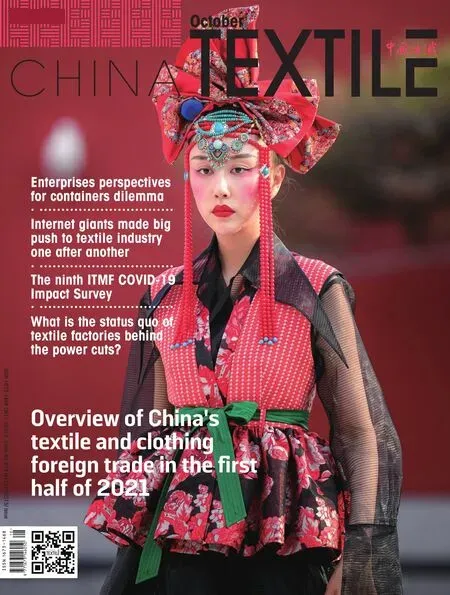Pandemic prevention materials exported fell rapidly
In the first half of this year, China's textile exports totalled 69.28 billion US dollars, down 7% year-on-year and up 18.2% compared with the same period in 2019, while garment exports totalled 74.11 billion US dollars, up 40.9% year-on-year and up 13.1% compared with the same period in 2019. Excluding masks, textile exports grew 48.8% year-on-year in real terms and 11.2% over the same period in 2019. Excluding protective clothing, apparel exports rose 54.4 percent yearon-year and 11.5 percent from 2019. In June, medical masks and protective suits were exported to USD 1.15 billion, down 76.6% year-on-year to USD 9.02 billion in the first half of this year.
Thee share of prevention and control supplies in exports has dropped rapidly. In the first half of this year, medical masks and protective clothing accounted for 6.3% of total textile and garment exports, down from 22.4% last year. In June, it fell to 4.05%, from 2.5% in 2018 and 2.7% in 2019, which was 54.2 percent in May last year. The impact of pandemic prevention materials on the overall export trend is gradually weakened, and the textile and garment export will further return to the pattern dominated by traditional commodities in the second half of the year.
Exports of major cities increased rapidly
In the first half of the year, the top five export provinces and cities grow fast, with double-digit growth rates except Guangdong. Zhejiang, Jiangsu, Shandong and Fujian grew 18.9 percent, 11.7 percent, 28.5 percent and 35.7 percent, respectively. Hebei, Jiangxi, Xinjiang and other regions all saw increases of 50 percent and more.
In terms of geographical regions, the eastern region remained the main driver of export growth. Thee cumulative export growth of the eastern region was 13.9 percent, while that of the western region was 30.7 percent. The central region declined by 2.9 percent from the high base of last year.
All commodities imports prices rose
Commodities as a whole performed well, in terms of yarns, fabrics, home textiles (excluding masks) and apparel. Among them, the export of needle-woven clothing increased by 37%, up 4.8% from 2019. Notably, exports of sportswear, including swimwear, have grown rapidly as the pandemic has eased. From January to June, China's exports of sportswear to the world increased by 50.23% year-on-year and 10.8% compared with the same period in 2019. Since March, the growth rate has expanded rapidly, and the growth rate in each month of the second quarter has reached or nearly doubled. It shows that with the opening of public activities, the demand for outdoor sports apparel in the global market picks up, and even forms a reciprocal growth to some extent.
In contrast to the export, which saw negative growth for two consecutive months after falling in the second quarter, the textile and garment import has maintained rapid growth for four consecutive months since March, with the growth rate exceeding 30% from April to June. Textiles increased by 10.2%, among which yarn, fabric and home textiles increased by 44.2%, 14.9% and 29% respectively.
Rising price is an important factor for the increase of imports. In terms of garments, the import prices of chemical fiber clothing rose relatively slowly, while those of other materials rose by more than 20%, and those of silk and wool clothing rose by more than 50%. Yarn fabrics and other import prices have also risen.

Cotton monthly import prices hit a new high
In the first half of 2021, China's overall cotton imports grew rapidly, with a cumulative import of 1.547 million tons, up 72.1% year-on-year. For example, cotton imports in June were flat with 172,000 tons, up 90.6 percent year on year. Imported cotton prices, which have been rising every month since November 2020, accelerated further in the second quarter of this year, reaching 2,040 dollars per ton in June, again the highest since January 2020.
Thee state continued to introduce measures to strictly control the rise of commodity prices in June, and textile enterprises maintained a high operating rate as a whole, and domestic cotton prices rose steadily. In June, the average price of China cotton price index was 15985 yuan per ton, up 35 yuan from the previous month, up 4027 yuan per ton year-on-year. International cotton prices are affected by the rise of commodities, the increase is greater than domestic.
Conclusion
Due to the large base of the same period last year, the overall export data is expected to be in the decline range in the third quarter, with a large decline, but the probability of double growth of commodities, including clothing, yarn, fabric and home textile products is pretty high. As the proportion of pandemic prevention materials fell in the same period last year, the decline in exports in the fourth quarter of this year will quickly narrow, and may even return to flat or growth.
Excluding the impact of contingencies, exports are expected to achieve a slight growth. If uncertainties are taken into account, such as large fluctuations in exchange rates, floods and weather factors, and repeated outbreaks in Europe and the United States, it is more likely to be the same or slightly lower than last year.
- China Textile的其它文章
- Overview of China's textile and clothing foreign trade in the first half of 2021
- Ministry of Commerce: China's foreign trade may encounter huge pressure next year
- Enterprises perspectives for containers dilemma
- Internet giants made big push to textile industry one after another
- Changes in China’s sportswear industry
- What is the status quo of textile factories behind the power cuts?

